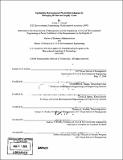| dc.contributor.advisor | Christopher L. Magee and Thomas A. Kochan. | en_US |
| dc.contributor.author | Vessell, Aimee L | en_US |
| dc.contributor.other | Leaders for Manufacturing Program. | en_US |
| dc.date.accessioned | 2007-04-20T15:55:09Z | |
| dc.date.available | 2007-04-20T15:55:09Z | |
| dc.date.copyright | 2006 | en_US |
| dc.date.issued | 2006 | en_US |
| dc.identifier.uri | http://hdl.handle.net/1721.1/37236 | |
| dc.description | Thesis (M.B.A.)--Massachusetts Institute of Technology, Sloan School of Management; and, (S.M.)--Massachusetts Institute of Technology, Dept. of Civil and Environmental Engineering; in conjunction with the Leaders for Manufacturing Program at MIT, 2006. | en_US |
| dc.description | Includes bibliographical references (p. 85-86). | en_US |
| dc.description.abstract | Many manufacturing companies wrestle with managing in-house manufactured inventories especially in the climate of Just-in-Time (JIT) manufacturing and with constant pressure to reduce inventory levels. One popular self-managing approach to controlling inventory levels while being responsive to customer demand is implementing a 'Pull' system. A Pull system is one that takes production signals from the downstream process and is based on true customer demand. This is in contrast to a 'Push' system that takes the production signal from the upstream schedule. This thesis will explore inventory management strategies at 3WA Powertrain Operation (PTO) as they approach plant wide implementation of 'Pull-to-Assembly'. 3WA PTO is working to completely link each of their in-house component (parts) production processes to the scheduled Assembly process such that component production signals will each 'pull' from the following process step and ultimately from the Powertrain Assembly schedule. The tested hypotheses include: 1) For 'Pull-to-Assembly' to be successful, a highly synchronized and visible in-house inventory management structure must first be in-place. | en_US |
| dc.description.abstract | (cont.) Successful inventory management requires that inventory levels for each component must be completely understood and tuned to the variety of the component, process lead time, demand and variability in both lead time and demand. 2) A Pull system, like any other manufacturing process or technology, requires effective integration of the human, organizational, and technical system features. 3) Transitioning from a primarily Push to a Pull system as well as implementing new inventory strategies requires effective management of change. This thesis leads with the analysis of technical features required to implement a Pull system at 3WA as well as to improve in-house inventory management methods. Included within this technical analysis is the presentation of a 'calculator' tool that allows the user to determine initial inventory levels appropriate for a given part based on the demand/lead time scenario. Following the more technical analysis, this thesis examines the organizational change and human elements needed to transition to and sustain a Pull system in this organization. The following overarching conclusions were developed based on observations, research and experimentation at 3WA PTO. | en_US |
| dc.description.abstract | (cont.) More specific conclusions related to the topics of 'Pull-to-Assembly, inventory management, data driven decision making, 'pulling' change in a tribal knowledge culture and the "demographic cliff' are presented within the thesis. Standardized processes and system stability along with accurate, knowledgeable and visible inventory management must be in-place before an extensive 'Pull' system will be successful. | en_US |
| dc.description.abstract | (cont.) There is no 'one-size fits all' for inventory management. Inventory management depends primarily on expected demand, lead time and the variability in both. Equally important to choosing an inventory strategy, however, is having a solid understanding of true customer needs including how they will signal demand, how often and how fast the product is needed. Change must be 'Pulled' from an organization for 'True Change' to happen. The 'demographic cliff' is approaching for many traditional manufacturing companies like 3WA and the right employee skills profiling, retirement policies, and knowledge retention/sharing strategies must be in place for both short-term and long-term company success. | en_US |
| dc.description.statementofresponsibility | by Aimee L. Vessell. | en_US |
| dc.format.extent | 86 p. | en_US |
| dc.language.iso | eng | en_US |
| dc.publisher | Massachusetts Institute of Technology | en_US |
| dc.rights | M.I.T. theses are protected by copyright. They may be viewed from this source for any purpose, but reproduction or distribution in any format is prohibited without written permission. See provided URL for inquiries about permission. | en_US |
| dc.rights.uri | http://dspace.mit.edu/handle/1721.1/7582 | |
| dc.subject | Sloan School of Management. | en_US |
| dc.subject | Civil and Environmental Engineering. | en_US |
| dc.subject | Leaders for Manufacturing Program. | en_US |
| dc.title | Optimizing the sequenced production schedule by managing the internal supply chain | en_US |
| dc.type | Thesis | en_US |
| dc.description.degree | S.M. | en_US |
| dc.description.degree | M.B.A. | en_US |
| dc.contributor.department | Leaders for Manufacturing Program at MIT | en_US |
| dc.contributor.department | Massachusetts Institute of Technology. Department of Civil and Environmental Engineering | |
| dc.contributor.department | Sloan School of Management | |
| dc.identifier.oclc | 85823988 | en_US |
